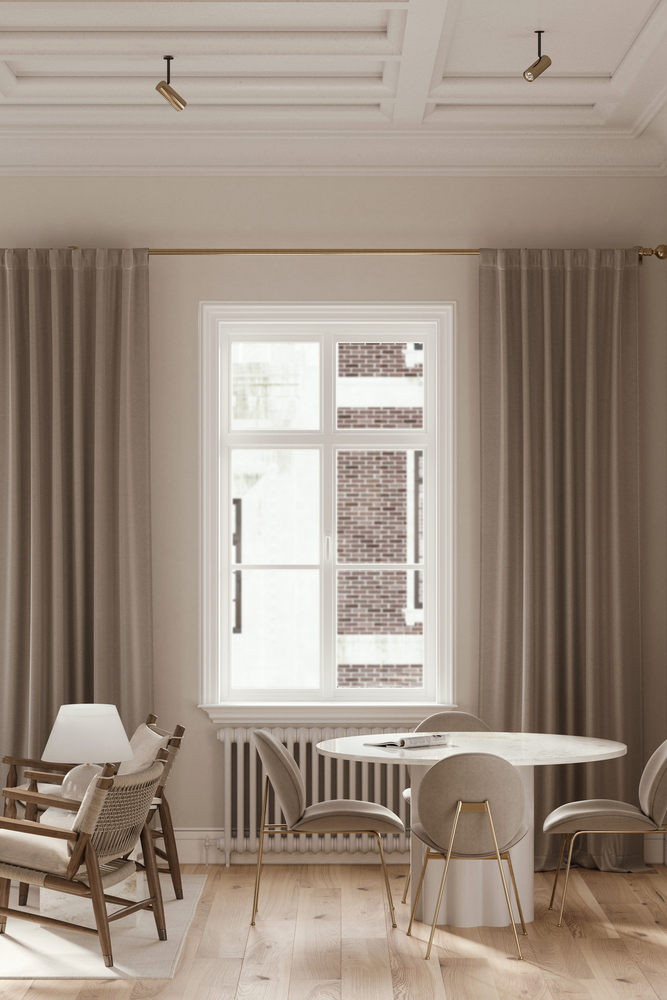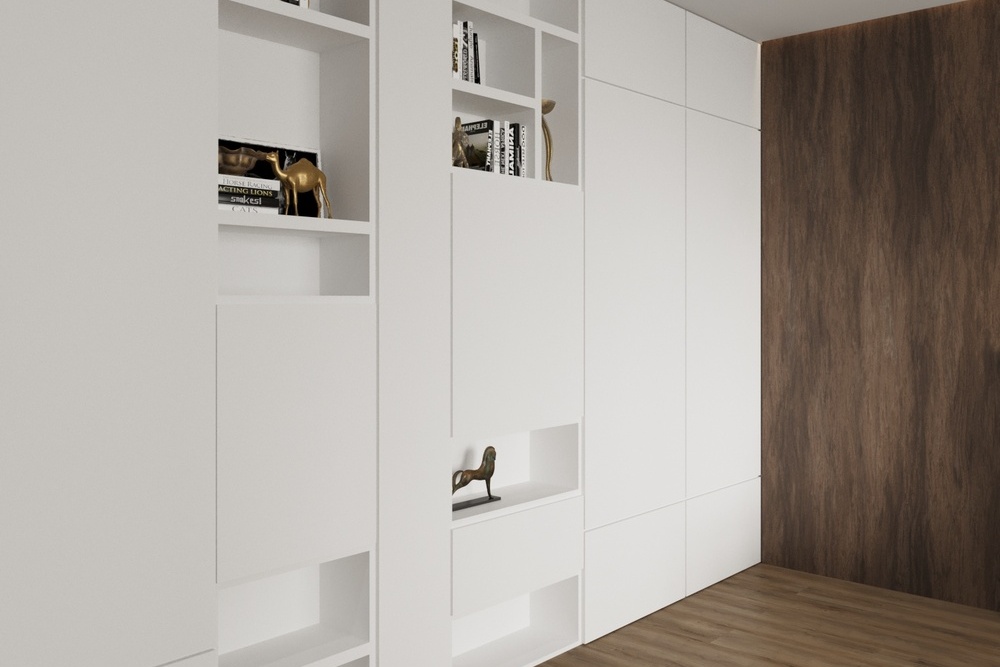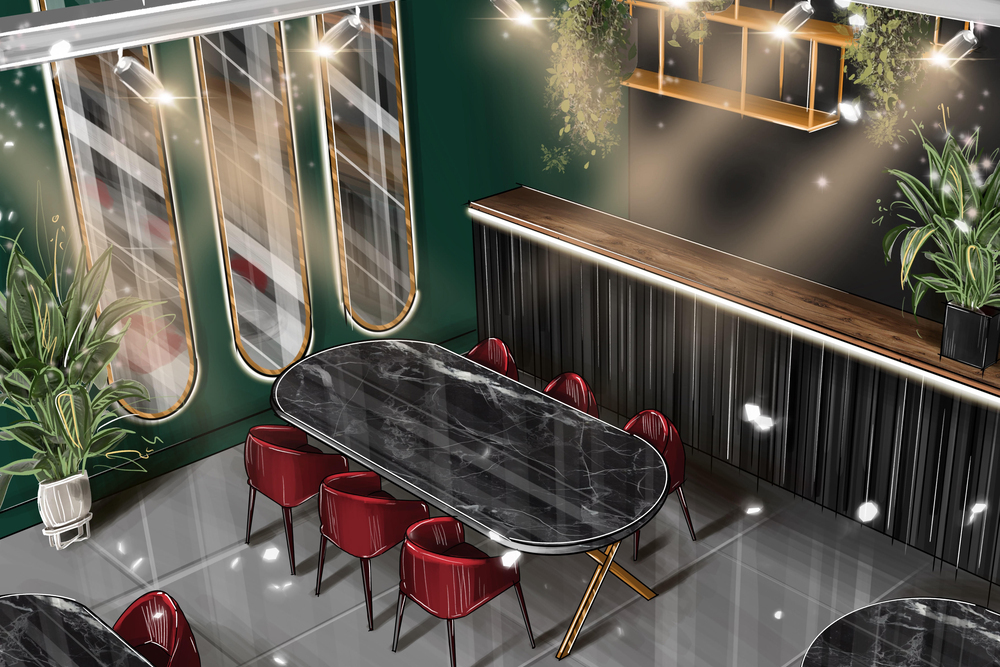To sign up for our daily email newsletter, CLICK HERE
In an ever-evolving world where technology and innovation continue to reshape our lives, there’s a growing appreciation for preserving and celebrating our cultural heritage. This appreciation extends to the world of interior design, where designers are increasingly seeking ways to incorporate elements of tradition and heritage into modern spaces. The result is a beautiful fusion of the old and the new, creating interiors that tell stories, evoke emotions, and pay homage to the past. In this exploration, we’ll delve into the fascinating realm of cultural fusion in interior rendering, uncovering the techniques, inspirations, and significance of blending heritage with modern design.
Explore stunning examples of cultural fusion in interior rendering at Yousee Studio and witness the magic of combining tradition with contemporary aesthetics.
The Power of Cultural Fusion
Preserving the Past: Our cultural heritage encompasses the traditions, customs, and aesthetics passed down through generations. It’s a repository of history and identity that deserves to be celebrated and preserved. Cultural fusion in interior design allows us to honor these traditions while adapting them to contemporary living.
Embracing Diversity: In today’s multicultural world, cultural fusion isn’t just a trend; it’s a reflection of our society. It showcases our ability to embrace diversity and appreciate the beauty of different cultures. Interior designers create spaces that resonate with many people by integrating elements from various heritages.
Storytelling Through Design: Every culture has stories, myths, and symbols. Cultural fusion in interior design offers a unique canvas for storytelling. It allows designers to convey narratives, evoke emotions, and immerse inhabitants and visitors in a rich cultural tapestry.
Elevating Aesthetics: Cultural fusion introduces a vibrant palette of colors, patterns, textures, and materials. This diversity can heighten the aesthetics of interior spaces, creating visually stunning and captivating environments.

The Techniques of Cultural Fusion
1. Incorporating Traditional Materials
One of the most effective ways to infuse cultural heritage into modern interior renders is through traditional materials. For example:
- Wood: Rich, dark wood can evoke a sense of warmth and history. Incorporating traditional wooden elements in furniture, flooring, or decor can instantly transform a space.
- Stone: Utilizing indigenous stone, such as granite or sandstone, in architectural elements or accent pieces can make interiors timeless.
- Tiles: Intricate mosaic tiles or hand-painted ceramic tiles are excellent for bringing cultural patterns and designs into kitchens and bathrooms.
2. Embracing Cultural Patterns and Textiles
Cultural fusion often involves integrating patterns and textiles associated with a particular heritage. These can include:
- Rugs and Carpets: Persian rugs, Moroccan carpets, or Navajo textiles can add a touch of culture to floors or walls.
- Fabrics: Upholstery, curtains, and throw pillows featuring traditional patterns and motifs can instantly transform the ambiance of a room.
3. Art and Decorative Pieces
Artifacts and decorative pieces from different cultures can be captivating focal points in interior renders. Consider:
- Sculptures: Sculptures from various cultures can be strategically placed to draw attention and tell a story.
- Wall Art: Paintings, tapestries, or masks can adorn walls and serve as a bridge between cultures.
4. Architectural Elements
Architectural elements with cultural significance can define the character of a space. These might include:
- Arches: Moorish arches, Romanesque arches, or Oriental archways can be integrated into doorways or windows.
- Ceilings: Intricately designed coffered ceilings or exposed wooden beams can add depth and history to a room.
5. Color Palette Selection
Colors carry cultural connotations. For instance:
- Red: Symbolic of luck and joy in many Asian cultures, red can be used as an accent color to infuse energy and vibrancy into a space.
- Blue and White: A classic combination of Mediterranean and coastal designs, blue and white can create a serene and timeless atmosphere.
6. Lighting Design
Lighting plays a vital role in setting the mood of a space. Consider:
- Lanterns: Moroccan lanterns or Japanese-inspired pendant lights can cast intriguing patterns and shadows.
- Candlelight: Candles in ornate holders or candelabras can create a warm, intimate ambiance reminiscent of various cultures.

Real-World Inspirations
We delved into the techniques and significance of blending heritage with modern design. Now, we’ll embark on a visual journey through real-world examples. We’ll witness how talented designers have seamlessly integrated cultural elements into modern interiors, creating spaces that are not only visually stunning but also deeply meaningful.
The Moroccan Oasis
Location: Marrakech, Morocco
This breathtaking interior design takes inspiration from Morocco’s rich architectural heritage. The heart of this design is the central courtyard, adorned with a traditional Moroccan water feature and surrounded by intricately designed arches. These arches are a nod to the Moorish influence that permeates Moroccan design.
The color palette is a vibrant mix of jewel tones, with deep blues, rich reds, and earthy greens dominating the space. Traditional Moroccan tiles, known as zellige, grace the walls and floors, creating mesmerizing geometric patterns. The lighting fixtures are exquisite, with intricate lanterns casting enchanting shadows.
The fusion here lies in modern furnishings with traditional Moroccan elements. Plush sofas and contemporary artwork coexist harmoniously with antique rugs and carved wooden screens.
The result? It is an oasis of cultural fusion where the past and present converge to create a truly immersive experience.
The Asian Elegance
Location: Kyoto, Japan
This interior render pays homage to the elegance of Japanese design. It’s a celebration of simplicity, minimalism, and Zen philosophy. The space’s focal point is a traditional tatami room with shoji screens that allow diffused natural light to filter in.
The color scheme is subdued, with a neutral palette of whites, creams, and soft grays. Natural materials like wood and bamboo add warmth and authenticity to the design.
One striking feature is the incorporation of a tokonoma, a niche in the room reserved for displaying art or prized possessions. In this case, a beautiful ikebana arrangement takes center stage, adding a touch of nature and impermanence to the space.
Cultural fusion here is about the marriage of Japanese aesthetics with modern comfort. While the design adheres to traditional principles, the furnishings are contemporary and inviting. It’s a space where one can experience the tranquility of Japanese culture without sacrificing modern conveniences.
The Mediterranean Retreat
Location: Santorini, Greece
Santorini is known for its stunning vistas, iconic blue-domed churches, and whitewashed buildings. This interior render transports the essence of Santorini into a modern living space.
The dominant colors are the whites and blues of the Aegean Sea. Whitewashed walls provide a canvas for the play of natural light, creating an atmosphere of airiness and serenity. The blue accents come from both the furnishings and the sea views outside.
The heart of the design is the inclusion of a traditional Greek fireplace. It serves as a gathering point and adds a rustic element to the otherwise contemporary space. The choice of comfortable seating and soft textiles ensures that modern comfort is not compromised.
Cultural fusion here is about capturing Santorini’s idyllic essence while offering modern living amenities. It’s a retreat that embodies the Greek spirit of philoxenia, the love of strangers, welcoming all who enter with open arms.
The Global Eclectic
Location: New York City, USA
New York City is a melting pot of cultures, and this interior render pays tribute to that diversity. It’s a celebration of eclecticism, where design elements worldwide come together.
The color palette is bold and vibrant, with rich jewel tones, earthy reds, and exotic patterns. The furnishings are a mix of styles, from mid-century modern to traditional. The walls are adorned with various artworks and textiles from different cultures.
One standout feature is using a Moroccan-style tile mosaic as a kitchen backsplash. It adds a touch of the exotic and becomes a conversation piece in the home. The lighting fixtures are equally diverse, with lantern-inspired pendants and modern chandeliers.
Cultural fusion here reflects the city—where people from different backgrounds coexist and contribute to a rich tapestry of experiences. Its design encourages exploration and appreciation of the world’s cultures.
Conclusion
These real-world examples illustrate the power of cultural fusion in interior rendering. They show us that modern design can be full of heritage and tradition. Instead, it can be a canvas where the past and present converge, different cultures find common ground, and beauty is redefined through diversity.
Techniques and Tips
In the previous segments of our journey through cultural fusion in interior rendering, we explored the significance of blending heritage with modern design. We witnessed real-world examples of how this fusion can create stunning and meaningful spaces. Now, we’ll delve deeper into the techniques and tips that interior designers employ to master the art of cultural fusion. These insights will help you infuse your projects with the richness of tradition while maintaining the functionality and aesthetics of contemporary design.
1. Research and Understanding
Before embarking on a cultural fusion project, investing time in research is essential. Understand the culture you wish to incorporate, its history, symbolism, and aesthetic principles. This knowledge will guide your design choices and ensure you respect the cultural elements you’re integrating.
2. Balancing Act
Cultural fusion is a delicate balancing act. Avoid overwhelming a space with too many cultural elements. Instead, select key pieces or features that will act as focal points and create a harmonious blend. These focal points should complement, not compete with, the overall design.
3. Colors and Textures
Colors and textures play a pivotal role in cultural fusion. Consider the color palettes and textures traditionally associated with the culture you’re drawing from. Integrate these into your design through paint, textiles, materials, and decor. Ensure that the chosen colors and textures harmonize with the overall color scheme.
4. Furniture and Decor
Carefully select furniture and decor that reflect the cultural heritage you’re incorporating. This could include intricately carved wooden furniture, handwoven textiles, or ceramics with traditional motifs. Mixing these pieces with modern furnishings can create a captivating juxtaposition.
5. Art and Artifacts
Art and artifacts provide an excellent opportunity to infuse cultural elements. Original artwork, sculptures, or handcrafted items from the culture can become striking focal points. Ensure that these pieces are displayed prominently and respectfully within the space.
6. Lighting
Lighting can dramatically affect the ambiance of a room. Consider lighting fixtures that align with the cultural theme. For example, Moroccan lanterns, Japanese paper lanterns, or Indian brass sconces can add authenticity and beauty to your design.
7. Flooring and Rugs
Flooring and rugs offer another layer of cultural expression. Traditional materials like hardwood, stone, or tile can be used to create a sense of authenticity. Rugs with intricate patterns or traditional motifs can serve as eye-catching design elements.
8. Architectural Details
Architectural details are often the most impactful aspects of cultural fusion. Incorporate arches, columns, or ornate moldings inspired by the culture you’re celebrating. These details can define the character of a space.
9. Customization
Consider customizing elements to align with the cultural theme. This could involve commissioning bespoke furniture or decor items inspired by the culture’s design heritage. Customization allows for a unique and personalized touch.
10. Functional Integration
While cultural fusion is about aesthetics and storytelling, ensuring that the integrated elements serve a functional purpose is crucial. For example, a traditional Moroccan tea table can be a decorative piece and a functional coffee table.
11. Avoid Cultural Appropriation
Cultural fusion should never cross into cultural appropriation. It’s essential to respect the cultures you’re drawing from and avoid using sacred or culturally sensitive items as mere decor. Seek permission or guidance from cultural experts when in doubt.
12. Consultation and Collaboration
For complex cultural fusion projects, consider collaborating with experts or consultants who understand the culture in question. Their insights can be invaluable in achieving authenticity and respect.
13. Continual Learning
The world is rich with diverse cultures, and there’s always something new to learn. Continue to educate yourself about different cultures and their design heritage. This ongoing learning will enrich your design repertoire and allow you to explore new avenues of creativity.

Conclusion
Cultural fusion in interior rendering is a powerful tool that allows us to celebrate heritage, embrace diversity, and create captivating spaces. By following these techniques and tips, you can navigate the complexities of cultural fusion with sensitivity and creativity. Remember that at its core, cultural fusion is about storytelling and creating spaces that resonate with the human experience.
Challenges and Ethical Considerations
As we conclude our exploration of cultural fusion in interior design, we focus on the critical aspects of challenges and ethical considerations. While cultural fusion can result in stunning and meaningful spaces, it also presents complexities and potential pitfalls that designers must navigate with sensitivity and responsibility.
1. Avoiding Cultural Appropriation
One of the foremost challenges in cultural fusion is avoiding cultural appropriation. Cultural appropriation occurs when elements of one culture are borrowed or taken by members of another culture without permission or understanding. It can be offensive and harmful, perpetuating stereotypes and erasing the significance of the borrowed elements.
To avoid cultural appropriation:
- Seek Permission: When incorporating elements from a specific culture, seek permission or guidance from individuals or groups belonging to that culture. Respect their expertise and insights.
- Understand Symbolism: Take the time to understand the cultural symbolism and significance of your elements. Avoid using sacred or culturally sensitive items as mere decor.
- Engage in Cultural Exchange: Cultural fusion should ideally involve a respectful exchange of ideas rather than a one-sided appropriation. Consider collaborating with artists or artisans from the culture you’re drawing from.
2. Balancing Authenticity and Aesthetics
Achieving a balance between authenticity and aesthetics can be challenging. While it’s important to honor the authenticity of cultural elements, designers must also ensure that the final design is visually pleasing and functional. Striking this balance requires careful consideration and sometimes compromises.
- Consult Cultural Experts: When in doubt, consult with cultural experts who can guide you in maintaining authenticity while meeting design goals.
- Selective Integration: Be selective in the cultural elements you incorporate. Rather than overwhelming a space, focus on a few key pieces with cultural significance.
- Respect Tradition: Pay attention to traditional craftsmanship and techniques when using culturally inspired materials or decor. This can enhance authenticity.
3. Respecting Cultural Diversity
Cultural fusion should celebrate diversity and inclusivity rather than homogenizing cultures. It’s essential to recognize that cultures are not monolithic entities but rich tapestries of different traditions, beliefs, and practices. Avoid the temptation to oversimplify or stereotype.
- Research Thoroughly: Invest time in thorough research to understand the nuances and diversity within the culture you’re exploring.
- Consult Diverse Voices: Engage with individuals or groups from the culture who represent a range of perspectives. This can help ensure a more holistic and nuanced approach.
4. Sustainability and Ethical Sourcing
Consider the ethical and sustainable aspects of cultural fusion projects’ materials and products. Be mindful of your choices’ environmental impact and suppliers’ ethical practices.
- Sustainable Materials: Choose materials that are sustainable and eco-friendly. For example, opt for reclaimed wood or recycled materials when possible.
- Fair Trade: Source products and materials from appropriate trade suppliers who ensure ethical practices and fair wages for artisans.
5. Cultural Preservation and Revitalization
Incorporating cultural elements can also play a role in preserving and revitalizing traditions. However, this should be done in collaboration with the culture’s custodians and with the goal of empowerment and cultural continuation.
- Community Involvement: Engage with local communities and artisans to support the preservation of traditional craftsmanship and practices.
- Education and Awareness: Use your projects to educate clients and the public about the cultural significance of your incorporated elements.
6. Legal and Copyright Considerations
Be aware of legal and copyright considerations when using cultural elements. Intellectual property laws may protect some artistic designs, motifs, or symbols.
- Research Copyright Laws: Ensure that you have the right to use specific cultural elements in your design without infringing on copyright or trademark laws.
- Attribute Appropriately: If you’re using designs or motifs requiring attribution, provide the necessary credit.
Conclusion
Cultural fusion in interior design offers a powerful means of celebrating heritage, embracing diversity, and creating captivating spaces. However, it comes with responsibilities and challenges that demand respect, sensitivity, and ethical consideration. By avoiding cultural appropriation, balancing authenticity and aesthetics, respecting diversity, and engaging in sustainable and ethical practices, designers can successfully navigate the complexities of cultural fusion while staying true to its spirit of celebration and respect.
As you embark on your cultural fusion projects, remember that the heart of this endeavor lies in storytelling. Each design is a narrative that honors the past, celebrates the present, and inspires the future. You can create spaces that tell stories of cultural richness, unity, and shared humanity through your work.